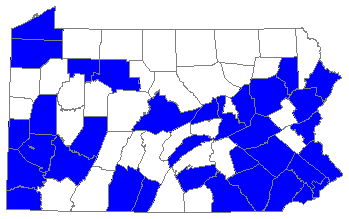 |
 

 |



Wild Indigo Duskywing (Erynnis baptisiae [Forbes])
Wing span: 1 3/8 - 1 5/8 inches (3/5 - 4.1 cm).
Identification: Upperside of forewing is dark on the basal half and lighter on the outer half, with a distinct orange-brown patch at the end of the cell. Male has a costal fold containing yellow scent scales; female has a patch of scent scales on the 7th abdominal segment.
Life history: Males perch in open areas on low shrubs to wait for females. Eggs are deposited singly on the host plant. Fully-grown caterpillars from the second brood hibernate.
Flight: Two broods from late April to early June and from July to August.
Caterpillar hosts: Usually wild indigo (Baptisia tinctoria), but also others including wild blue indigo (B. australis), lupine (Lupinus perennis), false lupine (Thermopsis villosa), and crown vetch (Coronilla varia).
Adult food: Nectar from flowers of blackberry, white sweet clover, dogbane, sunflower, crimson clover, and probably others.
Habitat: Open woods and barrens for native hosts. Highways, railroad beds, and upland fields for the introduced crown vetch.
Range: Southern New England and southern Ontario west to central Nebraska; south to Georgia, the Gulf Coast, and southcentral Texas. The Wild Indigo duskywing is rapidly expanding its range and abundance by colonizing plantings of crown vetch along roadways and railroad beds.
Comments: The Columbine, Wild Indigo, and Persius dusky wings belong to the "Persius complex," a confusing group of very similar butterflies.
Conservation: Not usually required.
The Nature Conservancy Global Rank: G5 - Demonstrably secure globally, though it may be quite rare in parts of its range, especially at the periphery.
Management needs: None reported.
References:
Opler, P. A. and G. O. Krizek. 1984. Butterflies east of the Great Plains. Johns
Hopkins University Press, Baltimore. 294 pages, 54 color plates.
Opler, P. A. and V. Malikul. 1992. A field guide to eastern butterflies. Peterson
field guide #4. Houghton-Mifflin Co., Boston. 396 pages, 48 color plates.
Scott, J. A. 1986. The butterflies of North America. Stanford University Press,
Stanford, Calif. 583 pages, 64 color plates.
Stanford, R. E. and P. A. Opler. 1993. Atlas of western USA butterflies including
adjacent parts of Canada and Mexico. Denver and Fort Collins, CO.
Author: Jane M. Struttmann
State and Regional References:
Glassberg, J. 1993. Butterflies Through Binoculars: A Field Guide to
Butterflies in the Boston-New York-Washington Region. Oxford Univ. Press,
New York, N.Y. 160 pp.
Layberry, R.A., Hall, P.W. & Lafontaine, D.J., 1998. The Butterflies of
Canada. University of Toronto Press, Toronto, ON. 280 pp.
Opler, P.A. 1998. A field guide to eastern butterflies, revised format.
Houghton Mifflin Co., Boston.
Shapiro, A.M. 1966. Butterflies of the Delaware Valley. American Entomological
Society Special Publication. Philadelphia, PA. 79 pp.
Tietz, H.M. 1952. The Lepidoptera of Pennsylvania. The Pennsylvania State
College School of Agriculture Agricultural Experiment Station. State
College, PA. 194 pp.
Wright, D.M. 1995, Atlas of Pennsylvania Butterflies. Special Private
Publication, Lansdale, PA. 22 pp.

